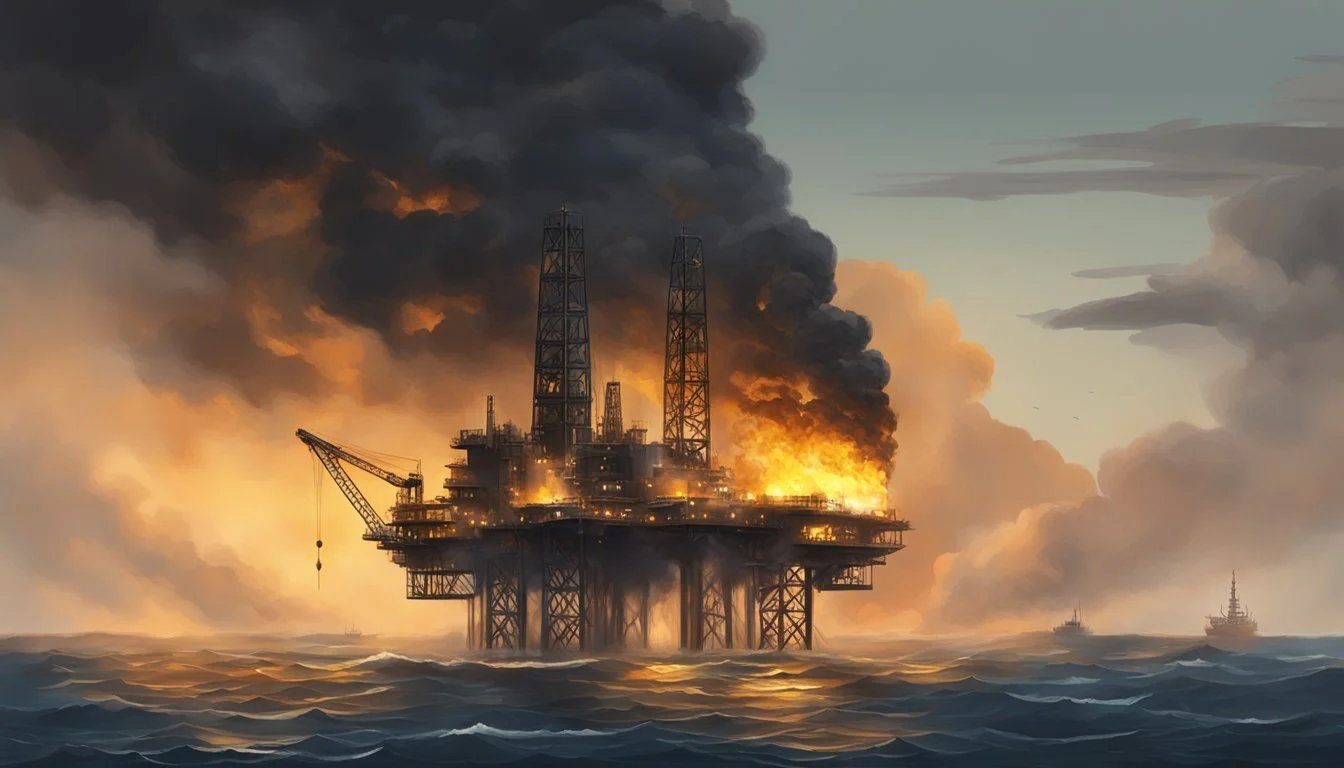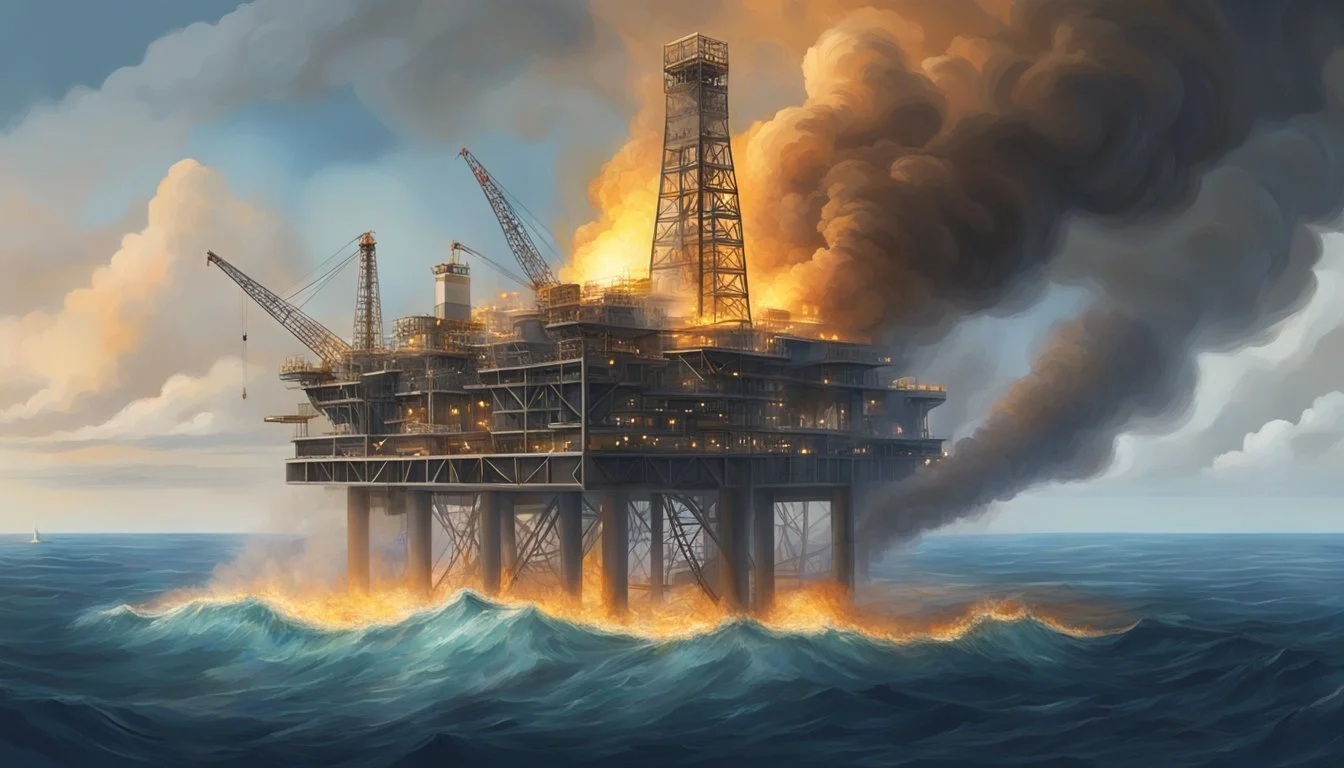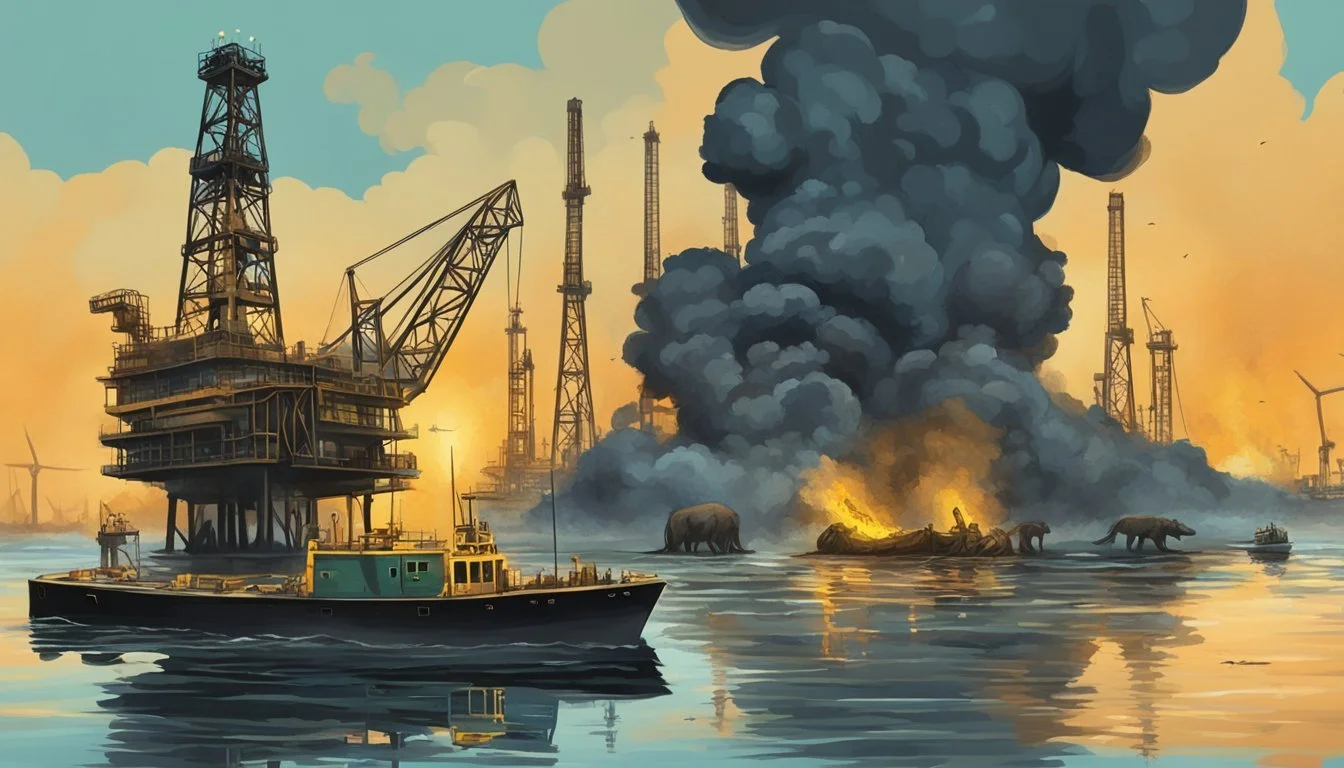The Actual Deepwater Horizon: Disaster in the Gulf of Mexico
Examining the Environmental Impact
On April 20, 2010, the Deepwater Horizon oil rig exploded in the Gulf of Mexico, triggering one of the worst environmental disasters in U.S. history. The blast killed 11 workers and unleashed a massive oil spill that would continue for 87 days.
The Deepwater Horizon incident released an estimated 3.2 million barrels of oil into the Gulf, causing widespread damage to marine ecosystems and coastal communities. The rig, owned by Transocean and operated by BP, was drilling an exploratory well in the Macondo Prospect when a blowout occurred, leading to the catastrophic failure.
The disaster exposed significant flaws in offshore drilling safety practices and regulations. It prompted extensive clean-up efforts, legal battles, and regulatory changes in the oil and gas industry. The environmental and economic impacts of the Deepwater Horizon spill continue to be studied and felt over a decade later.
Background of Deepwater Horizon
The Deepwater Horizon was an ultra-deepwater offshore drilling rig with a complex history. Its construction, ownership, and operational record provide crucial context for understanding the events leading up to the 2010 disaster.
Construction and Specifications
Deepwater Horizon was built in 2001 by Hyundai Heavy Industries in South Korea. The rig was a fifth-generation, dynamically positioned, semi-submersible mobile offshore drilling unit designed for operations in water depths up to 10,000 feet.
It measured 396 feet long by 256 feet wide and could accommodate a crew of 146. The rig featured advanced drilling technology, including a 21-inch outside diameter marine riser and six 5,500 horsepower thrusters for precise positioning.
Deepwater Horizon's derrick stood 242 feet high and could handle drill strings up to 35,000 feet long. The rig's sophisticated systems allowed it to maintain position in harsh weather conditions and drill in extremely deep waters.
Ownership and Operation History
Transocean Ltd. owned the Deepwater Horizon, having acquired it through a merger with GlobalSantaFe in 2007. The rig was leased to BP for operations in the Gulf of Mexico from 2001 to 2010.
During its operational life, Deepwater Horizon drilled several high-profile wells, including the deepest oil and gas well ever completed at the time - the Tiber Prospect in 2009, which reached a depth of 35,050 feet.
The rig operated primarily in the Macondo Prospect, located in Mississippi Canyon Block 252, approximately 41 miles off the Louisiana coast. This area was known for its challenging drilling conditions and high-pressure reservoirs.
Previous Incidents and Safety Record
Deepwater Horizon had a mixed safety record prior to the 2010 disaster. In 2005, the rig sustained damage during Hurricane Katrina but was repaired and returned to service.
Between 2000 and 2010, the rig experienced several incidents, including minor fires, equipment failures, and safety violations. In 2008, a dropped length of drill pipe caused damage to the rig's lower marine riser package.
Despite these issues, Deepwater Horizon was considered a top-performing rig in BP's fleet. It had received safety awards and set records for deepwater drilling operations. However, some reports suggested that maintenance and safety protocols were sometimes overlooked in favor of operational efficiency.
The Explosion and Fire
On April 20, 2010, a catastrophic blowout occurred on the Deepwater Horizon oil rig in the Gulf of Mexico. The resulting explosion and fire led to the deaths of 11 workers and initiated the largest marine oil spill in history.
Timeline of Events
At 9:45 PM, high-pressure methane gas from the well expanded into the drilling riser and ignited. The explosion rocked the platform, instantly killing several workers. Fireballs shot into the night sky as the rig was engulfed in flames.
Survivors scrambled to lifeboats amid chaos and darkness. Some jumped into the oil-slicked water 60 feet below. Two firefighting vessels arrived and began spraying water on the burning rig.
The fire raged for 36 hours, fueled by oil and gas from the well. On April 22, the Deepwater Horizon sank, causing the riser pipe to collapse and rupture.
Immediate Response
Coast Guard vessels and aircraft launched search and rescue operations within hours of the explosion. They rescued 115 of the 126 crew members from lifeboats and the water.
BP activated its crisis center and mobilized resources to respond to the unfolding disaster. The company deployed remotely operated vehicles (ROVs) to assess damage and attempt to activate the blowout preventer.
Environmental teams began preparing for potential oil spills. However, the true scale of the disaster was not yet apparent. Initial efforts focused on containing the fire and searching for missing workers.
Environmental Impact
The Deepwater Horizon oil spill caused widespread ecological damage in the Gulf of Mexico. Millions of barrels of crude oil contaminated marine habitats, harmed wildlife, and impacted coastal ecosystems. The disaster's effects continue to influence the region's environment years later.
Oil Spillage and Spread
An estimated 4.9 million barrels of crude oil spilled into the Gulf over 87 days. The oil formed a slick on the surface that covered up to 68,000 square miles.
Underwater plumes of oil droplets spread through deep ocean currents. These plumes extended for miles and impacted ecosystems at various depths.
Oil reached over 1,300 miles of shoreline across five states. Louisiana's coast was hit hardest, with oil contaminating beaches, marshes, and estuaries.
Effect on Marine and Coastal Ecosystems
The oil spill devastated marine life. Thousands of animals died, including sea turtles, dolphins, fish, and birds.
Oil coated birds' feathers, preventing them from flying and maintaining body temperature. Marine mammals suffered lung and liver damage from inhaling and ingesting oil.
Coral reefs in the deep sea showed signs of tissue damage and death when exposed to the underwater oil plume.
Coastal marshes and mangroves, critical habitats for many species, were smothered by oil. This damaged vegetation and disrupted the food chain.
Long-Term Ecological Consequences
Studies continue to reveal lasting impacts years after the spill. Some species still show elevated mortality rates and reduced reproduction.
Deepwater coral communities hit by oil show little sign of recovery. Their slow growth means damage could persist for decades.
Oil that sank to the seafloor continues to affect bottom-dwelling organisms. This may have long-term effects on the entire marine food web.
Coastal erosion has accelerated in some oiled areas due to the death of marsh plants that normally hold soil in place.
Response and Containment Efforts
The Deepwater Horizon disaster prompted an unprecedented mobilization of resources to address the environmental emergency. Multiple strategies were employed to contain the spill, clean up the oil, and mitigate its impacts on the Gulf ecosystem and coastal communities.
Containment Strategies
BP attempted several methods to stop the oil flow at the wellhead. Initial efforts included activating the blowout preventer and placing a containment dome over the leak, but these proved unsuccessful. Engineers then tried a "top kill" procedure, pumping heavy drilling mud into the well, which also failed.
On July 15, 2010, after 87 days of oil release, a "capping stack" was finally installed that stopped the flow. This custom-built device effectively sealed the well, ending the immediate crisis. Throughout this period, remotely operated vehicles (ROVs) played a crucial role in monitoring the situation and assisting with containment efforts.
Cleanup Operations
Cleanup efforts were massive in scale, involving thousands of workers and volunteers. Methods included:
Skimming: Vessels used specialized equipment to remove oil from the water surface
Burning: Controlled burns of oil slicks to reduce volume
Chemical dispersants: Controversial substances used to break down oil into smaller droplets
Boom deployment: Floating barriers to contain and absorb oil
Beaches and wetlands required extensive manual cleanup. Workers removed tar balls and oil-soaked debris from shorelines. Wildlife rescue operations were also undertaken to save affected animals.
Role of Government and Agencies
The U.S. government coordinated a multi-agency response. Key players included:
U.S. Coast Guard: Led on-scene command and coordination
NOAA: Provided scientific support and damage assessments
EPA: Monitored air and water quality
Fish and Wildlife Service: Managed wildlife protection efforts
Federal agencies worked alongside state and local governments to manage the crisis. The response involved over 47,000 personnel at its peak. The government also established a $20 billion fund, administered by Kenneth Feinberg, to compensate victims of the spill.
Legal and Economic Repercussions
The Deepwater Horizon disaster triggered massive legal battles and economic consequences. BP faced billions in fines and settlements, while Gulf Coast industries suffered significant losses. Compensation funds were established to aid affected individuals and businesses.
Litigation and Settlements
BP faced numerous lawsuits from federal and state governments, businesses, and individuals. In 2015, the company reached a historic $20.8 billion settlement with the U.S. government and five Gulf states. This agreement resolved civil claims under the Clean Water Act and natural resource damage claims.
The settlement included:
$5.5 billion in Clean Water Act penalties
$8.1 billion in natural resource damages
$5.9 billion to settle economic claims
BP also paid $4 billion in criminal fines and penalties. Other companies involved, such as Transocean and Halliburton, reached smaller settlements for their roles in the disaster.
Economic Impact on Gulf Industries
The oil spill severely affected Gulf Coast industries. Tourism suffered immediate losses as visitors avoided beaches and coastal areas. The fishing industry experienced long-term damage due to contaminated waters and public perception issues.
Key economic impacts:
$3.8 billion loss in tourism revenue (2010-2013)
10% decline in commercial fishing landings
$247 million decrease in seafood sales
Oil and gas industries faced increased regulations and temporary drilling moratoriums. This led to job losses and reduced economic activity in the region. The disaster's total economic impact is estimated to exceed $65 billion.
Compensation Funds and Distribution
BP established a $20 billion compensation fund to address claims from individuals and businesses affected by the spill. The Gulf Coast Claims Facility (GCCF) initially managed this fund, processing over 1 million claims.
In 2012, a court-supervised settlement program replaced the GCCF. This program paid out billions in claims to various groups:
Seafood industry: $2.3 billion
Individual and business economic losses: $11.8 billion
Property damage: $636 million
Despite these efforts, many claimants faced challenges in receiving compensation. Issues included complex claim processes, disputes over eligibility, and concerns about fairness in distribution.
Regulatory and Industry Changes
The Deepwater Horizon disaster sparked major reforms in offshore drilling safety and oversight. These changes reshaped regulations, industry practices, and global oil operations.
New Safety Regulations
The U.S. government implemented stringent new rules for offshore drilling after the Deepwater Horizon incident. The Bureau of Safety and Environmental Enforcement (BSEE) was created to enforce these regulations.
Key changes included stricter well design and blowout preventer requirements. Companies now face more rigorous inspections and must demonstrate their ability to contain potential spills.
The Well Control Rule, introduced in 2016, set new standards for drilling margins, real-time monitoring, and equipment maintenance. These measures aim to prevent loss of well control and improve emergency response capabilities.
Advancements in Disaster Prevention
The oil industry has invested heavily in new technologies and procedures to prevent future disasters. Enhanced blowout preventers with redundant shear rams have become standard.
Real-time monitoring systems now allow onshore experts to oversee offshore operations continuously. This improves decision-making and enables rapid response to potential issues.
Companies have also improved their oil spill response capabilities. New containment systems can be deployed quickly to cap wells and capture leaking oil. Regular drills and training exercises ensure preparedness for emergencies.
Impact on Global Oil Industry
The Deepwater Horizon disaster reverberated throughout the global oil industry. Many countries reassessed their offshore drilling regulations in light of the incident.
Oil companies worldwide faced increased scrutiny and higher operating costs due to new safety requirements. Some firms chose to divest from deepwater operations, deeming them too risky.
The disaster accelerated the industry's focus on safety culture. Companies now emphasize personal accountability and encourage employees to report safety concerns without fear of reprisal.
These changes have made offshore drilling safer, but also more expensive. This has influenced global energy strategies and investment decisions in the years following the Deepwater Horizon incident.
Personal and Societal Effects
The Deepwater Horizon oil spill had far-reaching consequences for Gulf Coast communities and individuals directly involved in cleanup efforts. Residents faced economic hardships and health risks, while workers experienced both immediate and long-term impacts from exposure to oil and dispersants.
Effect on Gulf Coast Communities
The spill devastated local economies dependent on fishing, tourism, and seafood processing. Many businesses closed permanently, leading to job losses and financial insecurity. Commercial fishing bans lasted for months in some areas. Tourism declined sharply as visitors avoided oil-contaminated beaches.
Property values plummeted in coastal areas, leaving homeowners with devalued assets. Some residents were forced to relocate due to lost livelihoods. The disaster strained social services and mental health resources as communities grappled with uncertainty and loss.
Cultural impacts were significant for indigenous tribes and fishing communities with deep ties to affected ecosystems. Traditional ways of life were disrupted, threatening cultural heritage and identity.
Health Impacts on Cleanup Workers and Residents
Cleanup workers reported respiratory problems, skin irritation, and headaches from exposure to oil and chemical dispersants. Some developed chronic conditions like asthma. Mental health issues such as depression, anxiety, and PTSD were common among workers and residents.
Gulf Coast residents experienced increased rates of physical and mental health problems in the years following the spill. Children were especially vulnerable, with some studies showing higher rates of physical and mental health issues.
Concerns about seafood safety and chemical exposure through air and water persisted long after the well was capped. Many avoided local seafood, impacting both diet and livelihoods.
Media Coverage and Public Perception
The Deepwater Horizon oil spill garnered intense media attention and shaped public perceptions of the disaster. News outlets provided extensive coverage, while social media platforms enabled rapid information sharing and facilitated public engagement.
Initial Reporting and Information Dispersion
Major news networks quickly deployed reporters to the Gulf Coast, providing live updates as the crisis unfolded. Television coverage showcased dramatic aerial footage of the oil slick spreading across the ocean surface. Print and online media published detailed infographics explaining the technical aspects of the blowout and containment efforts.
Social media platforms like Twitter and Facebook played a crucial role in disseminating information. Users shared eyewitness accounts, photos, and videos in real-time. This grassroots reporting often outpaced traditional media, though it sometimes led to the spread of unverified information.
Environmental organizations utilized social media to mobilize volunteers and coordinate cleanup efforts. They also used these platforms to advocate for stricter offshore drilling regulations.
Evolving Narratives and Advocacy
As the crisis dragged on, media narratives shifted. Initial reports focused on the immediate environmental impact and efforts to stop the oil flow. Later coverage examined the long-term ecological consequences and economic fallout for Gulf Coast communities.
Investigative journalists delved into BP's safety record and the regulatory failures that contributed to the disaster. These reports fueled public outrage and calls for accountability.
Environmental groups leveraged media attention to push for stronger offshore drilling oversight and investment in renewable energy. Their campaigns gained traction on social media, pressuring policymakers to act.
Public perception of the oil industry and government regulators soured. Polls showed widespread dissatisfaction with BP's response and skepticism toward claims about the spill's containment.
Lessons Learned
The Deepwater Horizon disaster led to significant changes in offshore drilling practices and disaster response protocols. Key advancements were made in safety regulations, environmental protection, and industry oversight.
Review of Disaster Response Protocols
Oil spill containment and cleanup procedures underwent major revisions following the Deepwater Horizon incident. New technologies were developed to cap underwater well blowouts more effectively. Improved dispersant application methods were implemented to minimize environmental impact.
Response teams now receive enhanced training in deep-water containment strategies. Coordination between government agencies and oil companies has been streamlined for faster mobilization during emergencies.
Regular drills and simulations are now mandatory to test readiness. Equipment stockpiles have been increased and strategically positioned along coastal areas for rapid deployment.
Educational and Policy Developments
Universities expanded research programs focused on offshore drilling safety and spill prevention. New courses in petroleum engineering now emphasize risk management and environmental protection.
Regulatory bodies strengthened oversight of offshore operations. Stricter safety standards were implemented, including more frequent inspections and improved blowout preventer designs.
Oil companies must now demonstrate the ability to rapidly contain underwater well failures before receiving drilling permits. Environmental impact assessments have become more rigorous, with greater emphasis on protecting marine ecosystems.
Industry-wide safety culture initiatives were launched to prioritize accident prevention over production goals. Whistleblower protections were enhanced to encourage reporting of safety concerns.




